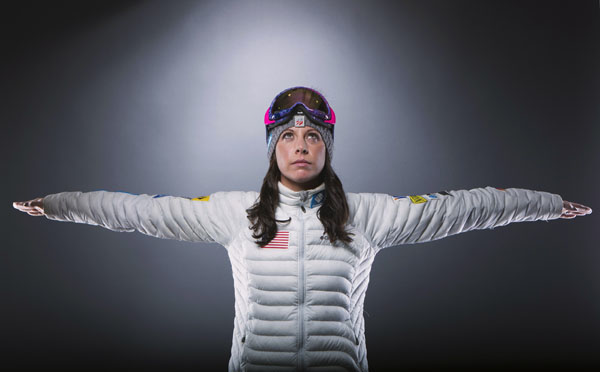QS athletes at 2014 Winter Olympics
Since the opening of the 2014 Winter Olympics last week in Sochi, Russia, much has been going on, including what seems to be the fiercest rivalry between the US and Canadian hockey women, as well as Jason Brown sensationally figure skating to Prince’s “The Question of U”. And even with such a long-standing tradition and culture behind the Olympic Games, many athletes at the 2014 Winter Olympics have already found ways to integrate the latest Quantified Self gadgets into their daily routines. One of them is Steven Nyman, an alpine skier, who couples his endless trainings with the data-driven practices of Troy Flanagan, director of high performance for the US ski team. Self-tracking for Nyman includes measuring his blood glucose, creatine kinase and urea every morning at 5:30am. But of course, on the flip side of this are athletes like Keri Herman and Tom Wallisch, both of whom are Slopestyle Skiers, who do not believe in self-tracking techniques or use wearable tech gadgets of any sort. For instance, to Tom, although Oakley’s new Airwave Smart Goggles, used by skiers to tell where they are on the mountain, altitude, etc. is pretty cool, it only serves as a distraction for him while competing in his events. Which side do you lean on for the Quantified Self movement?
Read more: At this year’s Olympics, the gold medal goes to the quantified self and Winter Olympics Photo of the Day: Skiing in the Sun
Image credited to Lucas Jackson | Reuters
Memories and decisions

Whether it is watching the Winter Olympics on television with your family or actually competing in the Games with thousands of supporters cheering you on, memories are being continuously created for every passing moment without you even noticing it. And if you think you’re having a memory problem just because what you and others recall about a particular incident over the last Winter Olympics is completely different, rest assured, you’re not always wrong. According to latest studies, the human brain edits memories relentlessly, updating the past with new information. And why do our brains do this? Scientists believe that the brain updates memories to make them more relevant and useful now — even if they’re not a true representation of the past. So even if you’re logging your life daily, we will have a tendency to modify these lifelogs to make sense of them ten or twenty years down the road. The good news? These lifelogs will be able to jolt our memories, and our brains could help us sort them automatically so that they’re the most relevant in the present. Better decision-making for the lifelogging individual, maybe?
Read more: Our Brains Rewrite Our Memories, Putting Present In The Past and Lifelogging: What it’s like to record your whole life
Image credited to NPR and iStockphoto
Be proud of your selfies

Speaking of recording our memories, a new trend has been taking the Instagram world by storm. In fact, there are more than 75 million photographs on Instagram marked with this popular hashtag. Yes, you got it – snap it, upload it and finally #selfie. And even after the word “selfie” has been officially incorporated into the Oxford Dictionary, much hatred or mocking have been directed at users who flood their Instagram accounts with nothing but their self-portraits. Yet, earlier, we also talked about how Dove’s selfies project actually revealed the insecurities that these girls possessed, and subsequently got them to see how beautiful they really are. So are #selfies really that detestable? In this article, the author justifies the case for selfies. According to her, there’s no need to be sorry for your selfie because it has been around for a long time. And for the very fact that we can #selfie every day or waking moment of our lives, is indicative of progress, since the selfie barrier to entry is no longer restricted by wealth, time and privilege like it was with the French monarch of the past. #Sorrynotsorry for my #selfie anymore (;
Read more: Why You Should Never Be Sorry for Your Selfie
Image credited to NASA
Be proud of your Narrative Clip selfies

Now case in point. If you have a Narrative Clip and you’re wondering what to do next besides just clipping it to the collar of your shirt, well how about this? How about giving the Narrative Clip #selfie a shot? Letting her creative juices flow, author Bianca Bosker at Huffington Post has experimented various ways to use the Narrative Clip – clipped to her clothes, strapped on her purse, fastened to a dog and propped up on her desk, where it takes numerous selfies of her. And with these selfies, she noticed some bad habits of hers replaying over and over – the nibbling, the lip-biting, the squinting, and of course, the snacking. Yet, we’re stoked to hear how her experience has been. In her words, “The Narrative Clip didn’t just let me “relive life’s special and everyday moments,” as the ad copy on the camera’s sleek box had promised. When I scrolled through the thousands of photos it captured, I had the feeling of discovering entirely new dimensions to an experience I thought I knew. It both jogged my memory and fiddled with it.” Thank you and we can’t wait to hear from more of you!
Read more: Nice To Meet You. I’ve Already Taken Your Picture
Image credited to Huffington Post
If you enjoyed this post, you can also subscribe to our monthly newsletter!


